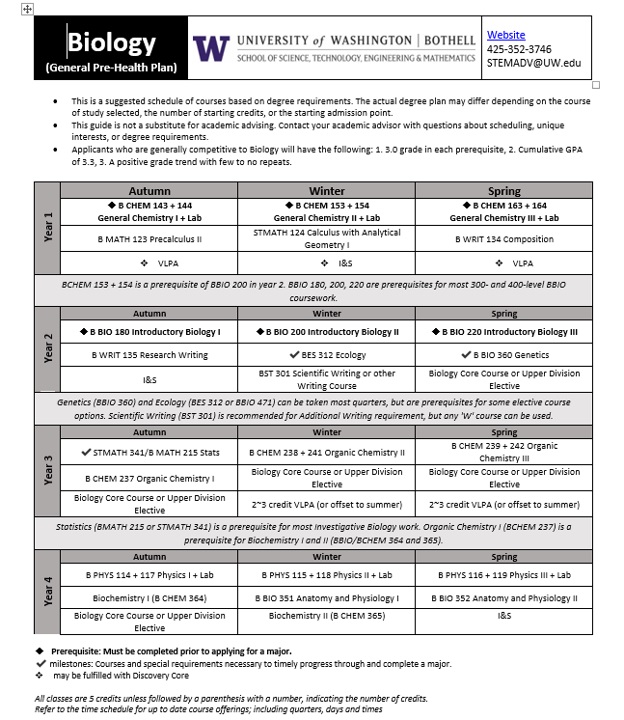
When Shugla Kakar, a first-generation student, came to the University of Washington Bothell to start a pre-med program, she had a hard time with her schedule. “I had no idea I should have taken my math classes, so I ended up missing my first chem sequence,” she said.
Michael Albellar, also a first-generation pre-med student, didn’t know how to merge cocurricular activities with courses. “I didn’t know when to start shadowing and volunteering,” he said.
When Djelli Berisha was first looking at a college catalog with his mother, they didn’t see when he should take courses — “no distinct pathways,” he said.
From now on, thanks to a series of academic “degree maps” created by advisers in Office of Undergraduate Learning in collaboration with faculty across campus, students will have a much better sense of how to complete their degrees.
Inspiring institutional change
Kakar, Albellar and Berisha are some of the students who wanted to see the entire arc of the academic career ahead of them so that they could compare possible majors and plan cocurricular activities. They needed road maps to 180 credits.
Now, as leaders of the Associated Students of the University of Washington Bothell, they helped inspire a change in academic planning.
UW Bothell’s new series of degree maps outline a sequence of suggested courses, quarter-by-quarter, for each baccalaureate major.
“It’s a really great way for students to be able to navigate their entire college experience,” Berisha said.
Kakar, ASUWB president, credits Berisha, director of advocacy, and Albellar, senator for advocacy, with continuing work started by two other ASUWB advocacy leaders, Afua Tiwaa and Warisha Soomro.
Kakar, Tiwaa and Soomro first took their requests to the Office of Undergraduate Learning (also known as the First Year & Pre-major Program). They met with Cinnamon Hillyard, interim associate vice chancellor for undergraduate learning, and Kathy Mitchell, assistant director of undergraduate learning initiatives.
To research how best to respond to students, Hillyard and Mitchell convened a working group of faculty, staff and students. Nearly two years and a lot of hard work later, UW Bothell now has a suite of 48 degree maps — one for each major and concentration — in the form of PDF documents.
Creating degree maps

“It took heavy lifting from deans, curriculum people, academic advisers and faculty,” said Hillyard, “countless hours organizing degrees and getting feedback.”
It also changed institutional thinking that was often divided between a two-year pre-major and a two-year major framework to envision instead a more organized four-year experience, Hillyard said. “Now people are thinking forward about how to use this.”
Starting this winter quarter, when UW Bothell students check Canvas (their course software), they’ll find a tab where they can see all the degree maps for their school.
Soon, the maps also will be visible to the public so prospective high school and transfer students, parents and even high school advisers can download the maps.
Primarily intended at keeping students on track for their major and graduating on time, the degree maps evolved to include cocurricular activities and how to apply credits earned in advanced high school classes, said Berisha, a sophomore majoring in Biology.
Being able to see which credits transfer from high school or community college will help students avoid unnecessary courses and focus on what they need for admittance to their major, said Albellar, a junior majoring in Biology.
“It is our hope that students take advantage of this great resource we now have available. I hope advisers use it as well. It can make everyone’s life easier,” said Kakar, who graduates in June with majors in Health Studies and in Gender, Women & Sexuality Studies.
Looking to the future

The degree maps should reduce anxiety for the nearly 1,700 pre-major students on campus — about 29% of all students. The maps can help direct them into their majors before their junior year, giving them time to make the most of options and opportunities.
“It changes how we guide and inform students,” said Mitchell, an experienced adviser who helped design and develop the maps.
The degree maps also align with the Guided Pathways initiative of the Washington State Board for Community and Technical Colleges, Mitchell noted.
Implementing degree maps was a big undertaking — but worth every meeting, design conversation and pathway negotiation, she said.
“It helps students visualize where they’re going and feel like they belong, that they have a path.”
The new academic degree maps will be officially launched at an event from noon to 2 p.m. Jan. 29 in the Activities & Recreation Center. Poster-size versions of each degree map will be on display with the advice: “Map it out. Plan it out.”


